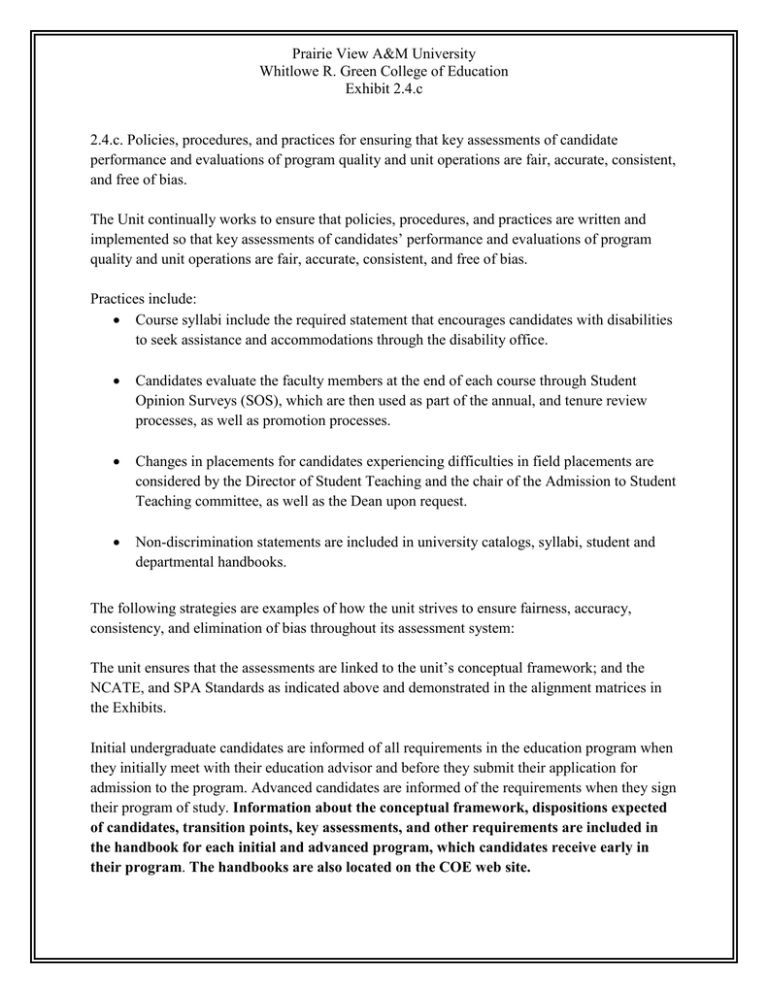Prairie View A&M University Whitlowe R. Green College of Education Exhibit 2.4.c
advertisement

Prairie View A&M University Whitlowe R. Green College of Education Exhibit 2.4.c 2.4.c. Policies, procedures, and practices for ensuring that key assessments of candidate performance and evaluations of program quality and unit operations are fair, accurate, consistent, and free of bias. The Unit continually works to ensure that policies, procedures, and practices are written and implemented so that key assessments of candidates’ performance and evaluations of program quality and unit operations are fair, accurate, consistent, and free of bias. Practices include: Course syllabi include the required statement that encourages candidates with disabilities to seek assistance and accommodations through the disability office. Candidates evaluate the faculty members at the end of each course through Student Opinion Surveys (SOS), which are then used as part of the annual, and tenure review processes, as well as promotion processes. Changes in placements for candidates experiencing difficulties in field placements are considered by the Director of Student Teaching and the chair of the Admission to Student Teaching committee, as well as the Dean upon request. Non-discrimination statements are included in university catalogs, syllabi, student and departmental handbooks. The following strategies are examples of how the unit strives to ensure fairness, accuracy, consistency, and elimination of bias throughout its assessment system: The unit ensures that the assessments are linked to the unit’s conceptual framework; and the NCATE, and SPA Standards as indicated above and demonstrated in the alignment matrices in the Exhibits. Initial undergraduate candidates are informed of all requirements in the education program when they initially meet with their education advisor and before they submit their application for admission to the program. Advanced candidates are informed of the requirements when they sign their program of study. Information about the conceptual framework, dispositions expected of candidates, transition points, key assessments, and other requirements are included in the handbook for each initial and advanced program, which candidates receive early in their program. The handbooks are also located on the COE web site. Prairie View A&M University Whitlowe R. Green College of Education Exhibit 2.4.c Rubrics to assess candidates’ work are shared with the candidates before the rubrics are used. Thus, candidates know what they will be assessed on, what is expected of them, and the level of proficiency associated with each scoring decision. At the beginning of each semester, the Director of Student Teaching and Field Experiences discusses the rubrics that are used to assess candidates with the student teachers, cooperating teachers, and university supervisors. Rubrics that are used for program specific assessments are discussed with the candidates each semester by the program faculty members. Data are triangulated wherever possible to enhance the reliability of findings. For example, many of the same questions are asked on the “Program Completer Survey,” “Graduate Follow-Up Survey,” and “Employer Survey” for both the initial and advanced programs. Also for the initial programs, the student teacher, cooperating teacher, and university supervisor each independently completes the disposition survey at the end of the semester. In order to show candidate progress during a semester, some performance assessments e.g. the PDAS may be administered twice--first for practice with suggestions provided for remediation by the instructor, and then for a final score or grade (e.g., PDAS, and Cooperating teacher evaluation).



